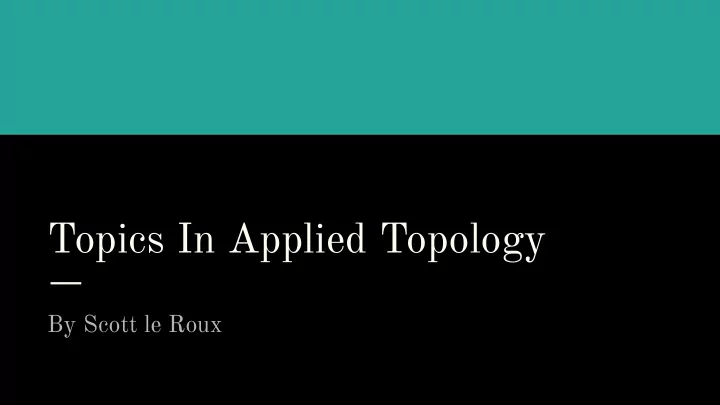

Topics In Applied Topology By Scott le Roux
Introduction In this presentation I will discuss various applied fields in which Topology is present. I will talk about the pure topological concepts which appear in these real world areas and explore some computational techniques and algorithms used to solve problems in these fields. Motivation I wanted to partake in the DRP in order to continue actively learning and discovering new areas of mathematics. I wanted to both build on previous work in research and hopefully set a guideline for my senior research project next year.
Molecular Modelling Molecular Modelling as the name suggests is the process of modelling molecules. The motivation for this field is Protein folding. Geometric definition of a folded protein “What role a protein takes in the grand opera Depends on exactly one thing: its shape” And that is where Topology comes in to help understand the structure and function of the protein through Topological concepts
Topological representation This is the real While the solvent is being The cells with non-empty version of a 2D shrunk to a point the protein intersections form protein. The circle is increased in size. Leaving simplices from there us with ∪ B balls. This is then surrounding it is the centres. The Dual solvent or radius r. decomposed into weighted Complex all these voronoi cells giving us the simplices. This is above image. homotopy equivalent to ∪ B
Void Voids and Pockets Interesting things are voids and cavities (pockets). 2nd betti number counts the voids, bounded components in the complement of ∪ B. These are of interest due the possibility of trapped water molecules during folding process which can impact future evolution. Pocket Pockets are even more important as they determine the way proteins interact. Pockets are points which the gradient of a smooth function f doesn’t tend to infinity. Where f is min weighted distance to any ball. Pocket is a maximal connected piece of space in complement. Close relationship to delaunay simplices allows algorithms to compute these to be analysed.
Image Processing An Pixel is a unit square and an Image is a rectangle decomposed into pixels. We can define 4-adjacent as sharing edge 8-adjacent as sharing vertices. Hence 4-adjacent ⟹ 8-adjacent Simple if two pixels adjacent ⟺ contiguous. Closed if the last pixel is adjacent to the first pixel. Therefore a i-connected simple closed curve is a closed curve where each pixel is i-adjacent to the contiguous pixel.
Jordan Curve theorem for Images Jordan curve theorem . The image version is: A simple closed i-connected curve partitions image into the path and two j-connected components. Where i,j ⋲ {4,8} and i ≠ j. This version of the Jordan Curve theorem can be extended to higher dimensional arrays with cubes and hypercubes. 4-connected jordan curve (blue) Partitions into two 8-connected regions (red, orange) and itself.
Skeletonizing Skeletonizing is the process of replacing the foreground with its skeleton. This can be expected to be a thin subset reflecting its connectivity. One class of algorithms that compute the skeleton erode the foreground layer by layer, removing pixels as long as the connectivity remains intact. Inner & Outer Boundaries Outer boundaries are Curves C such that the bounded foreground component is inside the curve. We can decipher whether a curve is an inner or outer boundary by its winding numbers . We can traverse the curve adding supplementary angles at the centre Skeleton of binary points of contiguous pixels. The angles sum to ∓ 360 as the curve is image of a telephone simple. If it’s negative it means the curve is an outer boundary.
Conclusion I discovered areas of interest in the real world where I can apply my knowledge and interest in Topology, a seemingly pure mathematical subject with few non - abstract applications. I further developed my skills in using papers and references to dive deeper into a certain field. This will help me stepping forward for to do my senior research project next year.
References 1. Computational Topology , Tamal K. Dey, Herbert Edelsbrunner, Sumantha Guha. 2. Extraction of Robust Voids and Pockets in Proteins, Raghavendra Sridharamurthy, Harish Doraiswamy, Siddharth Patel, Raghavan Varadarajan, Vijay Natarajan, Computer Science and Automation Indian Institute of Science, India May 2013
Recommend
More recommend